Summer 2024
Target: The Pinwheel Galaxy, Messier 101 (M101/NGC5457)
Status: Complete
The Pinwheel Galaxy (also known as Messier 101, M101 or NGC 5457) is a face-on, unbarred, and counterclockwise spiral galaxy located 21 million light-years (6.4 megaparsecs) from Earth in the constellation Ursa Major. It was discovered by Pierre Méchain in 1781 and was communicated that year to Charles Messier, who verified its position for inclusion in the Messier Catalogue as one of its final entries. M101 is a large galaxy, with a diameter of 170,000 light-years. By comparison, the Milky Way has a diameter of 87,400 light-years. It has around a trillion stars. It has a disk mass on the order of 100 billion solar masses, along with a small central bulge of about 3 billion solar masses. Its characteristics can be compared to those of Andromeda Galaxy. [Source: Wikipedia]
The image below consists of approximately 63 hours of imaging data, with over 87 hours contributed (~24 hours was discarded due to poor guiding, clouds, etc.). Several images were generated using Siril and Pixinsight for processing, and the group selected the one below, by Mike W., to represent the efforts of everyone involved.
The BHAS members who contributed data to the project, the equipment used, and the amount of data from each is shown below. Acronyms: L: luminance filter, R: red filter, G: green filter, B: blue filter, Ha: hydrogen alpha filter, OSC: one shot color camera. x@ys = x images with an exposure of y seconds for each image (e.g. 82@180s = 82 images, each image exposed for 180s).
| Equipment | Data | |
| Kevin C. | Telescope: Askar 130PHQ Mount: iOptron CEM70G on iOptron Permanent Pier Camera: QHY268M Pro |
L: 82@180s = 14760s R: 45@120s = 5400s G: 58@180s = 10440s B: 60:120s = 7200s Total: 37800s |
| Hank F. | Telescope/Mount: Celestron NexStar Evolution 8 Camera: Mallincam DS 10C |
OSC: 234@120s = 28080s |
| Chris K. | Telescope: TSOptics f/11 ED refractor Mount: iOptron CEM70 Camera: QSI683wsg-8 or ASI533MC Pro |
L: 94@300 = 28200s R: 32@300 = 9600s G: 47@300 = 14100s B: 34@300 = 10200 Total: 62100s |
| Rod M. | Telescope: Planewave DeltaRho 350. Aperture: 350mm, focal length: 1050mm. Mount: Bisque Paramount MX+ (Upgraded to MKS 6000 Electronics) Camera: Moravian C3 61000EC PRO (Monochrome) |
L: 89@240 = 21360s R: 36@240 = 8640s G: 21@240 = 5040s B: 29@240s = 6960s Ha: 29@300 = 8700s Total: 50700s |
| Ken T. | Telescope: Explore Scientific ES152 Mount: Celestron CGEM DX Camera: ASI293MC Pro |
OSC: 130@180 = 23400s |
| Rick V. | Telescope: Celestron f/5 Newtonian, Aperture 200mm, focal length 1000mm Mount: Celestron AVX Camera: ASI533MC |
OSC: 272@120 =32640s |
| Richard W. | Telescope: Orion 8″ Newtonian Mount: Camera: QHY268M Pro |
Ha: 145@300 = 43500s |
| Mike W. | Telescope: Askar 151 PHQ Mount: ZWO AM5 Camera: ZWO ASI 6200MM Pro |
L: 75@240 = 18000s R: 38@240 = 9120s G: 30@240 = 7200s B: 37@240 = 8880s Ha: 69@300 = 20700s Total: 45270s |
| Totals: | OSC: 84120s L: 56940s R: 32760s G: 36270s B: 33240s Ha: 72900s |
|
| 87 hours, 50mins, 24 seconds (87.84 hours) |
Accounting for images that were discarded due to guiding errors, poor skies, etc., the following totals for each channel were used in the final image. The combined, unprocessed channel is also shown.
| Time | Combined Channel | |
| OSC: | 61740s | 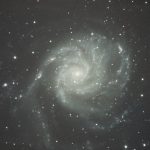 |
| L: | 74730s | 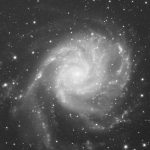 |
| R: | 29640s | 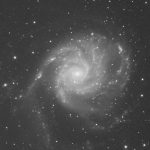 |
| G: | 32580s | 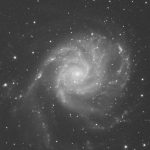 |
| B: | 30780s | 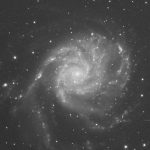 |
| Ha: | 22800s | 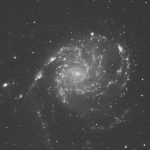 |
| Total: | 229470s (63 hours, 44min., 30s) | |




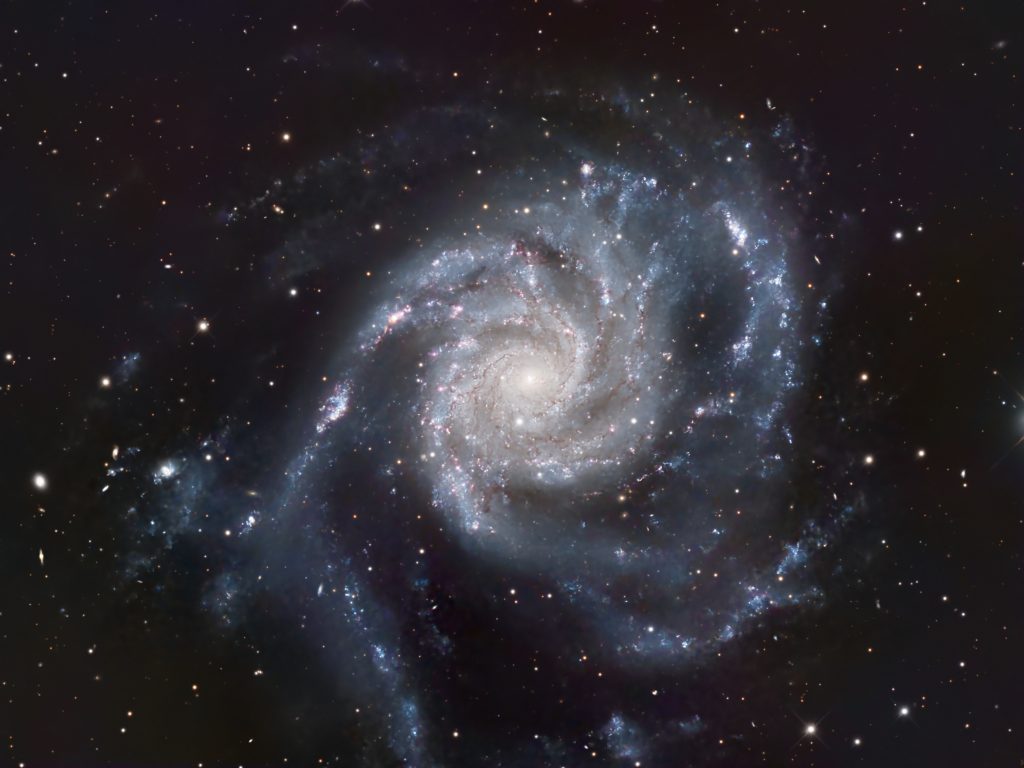
What coordination what a pinwheel !